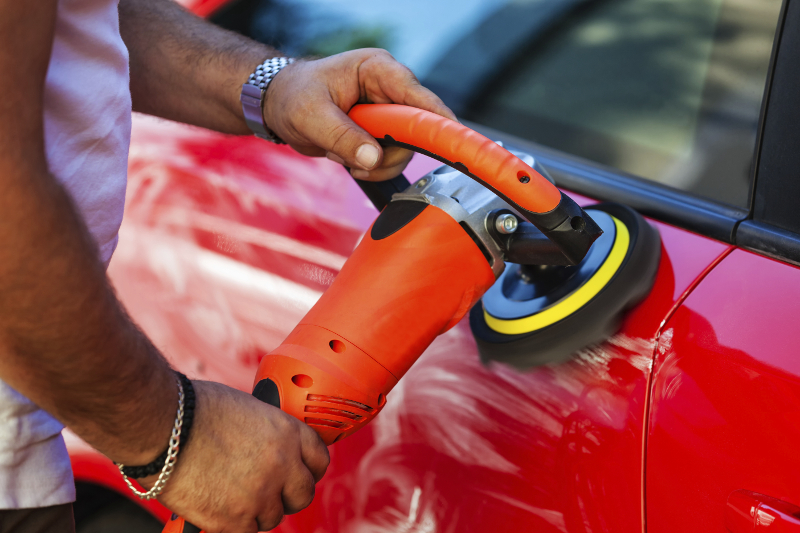
Electric buffers can speed up the car waxing process considerably. They also allow for even wax distribution and additional paint shine to give your ride that amazing look you’ve always wanted.
While waxing vehicles doesn’t always require the use of an electric buffer since you can also buff by hand, the job does become easier and less time consuming with the help of the said piece of equipment. The prospect of using an electric buffer for waxing may be slightly intimidating at first, but as you familiarize yourself with the machine and the process, you’ll realize that it’s actually both an easy and satisfying endeavour.
A Step-by-Step Guide to Waxing With a Buffer
A machine buffer should allow you to go about the car waxing process twice as fast. It can save you more time than waxing by hand, making it the more practical choice of the two.
Before you start the process, make sure to gather all the required materials, including liquid wax, microfiber towels, a wax applicator pad, a wax removal cloth, and a machine buffer. Once you’ve got all these covered, follow the steps below to achieve the perfect shine for your vehicle.
Step #1: Look for a Shaded Area to Work In
When it comes to waxing, the sun is not your friend. The sun can cause the wax to dry too quickly before you even finish applying, creating all sorts of problems. You’ll want to work in the shade, preferably in a garage, where you don’t have to worry about any of the potential setbacks caused by waxing in an outdoor environment.
Step #2: Prepare the Car’s Surface
Before you begin waxing your ride, make sure to wash it thoroughly. Then, use a clay bar to remove any stuck-on dirt and debris.
This is how you can get the paint to look and feel as smooth as glass, which is how it should be before wax application. Double-check to make sure no soapy residues are left, and the car is completely dry before proceeding to the next step.
Step #3: Apply Liquid Wax
Attach the wax applicator to the buffer pad of your machine buffer. Then, without turning on the buffer, apply wax to your car using vertical or horizontal linear movements. Lastly, turn the buffer on and use it to apply wax gently all over your car’s surface. Remember never to put too much pressure on the buffer so that you don’t accidentally damage the paint.
The buffer should glide effortlessly across the surface of your vehicle without any weight behind it. It should follow the same direction; the metal flows to ensure seamless application. Once that’s done, let the wax dry completely so that it gives your vehicle that hazy look.
Step #4: Buff the Car’s Surface
Detach the wax applicator pad from the buffer and replace it with a wax removal cloth. Power on the machine and buff off the wax using long, linear strokes and light pressure. Never use circular motions when buffing since this could leave behind swirl marks on your vehicle’s surface.
The key to doing this successfully is to guide the tool and let it do the work on its own. With this in mind, you shouldn’t have too much trouble buffing your car.
Machine Buffers to Choose From
The market has two main types of buffers to offer: the variable-speed rotary polisher and the dual-action orbital polisher. We will go over their pros and cons and the different skill levels required to use them.
1. Variable-Speed Rotary Polisher
If you’re completely new to using a machine buffer, you may want to steer clear of the variable-speed rotary polisher. While great at removing swirl marks, heavy scratches, and other types of heavy damage, this tool makes it just as easy for beginners to damage the car surface by applying too much pressure.
2. Dual-Action Orbital Polisher
Here’s one that’s perfect for beginners. Unlike its counterpart, the dual-action orbital polisher spins normally in both directions, making it easier to use and control. It’s perfect for waxing because you don’t feel the urge to put too much pressure behind it.
Auto-detailing enthusiasts recommend using this device if you aren’t dealing with a heavily-damaged car surface. If your car is well taken care of and has minimal scratches, the dual-action orbital polisher has got you covered.
The Bottomline
Waxing a car with a machine buffer not only makes the job a lot easier, but it also ensures even distribution of wax and spectacular results. If you haven’t given it a try, we suggest you do so during the next scheduled waxing. Until then, start familiarizing yourself with the process, learning about the different types of electric buffers in the market, and going over our easy step-by-step guide to waxing your car using a buffer.
